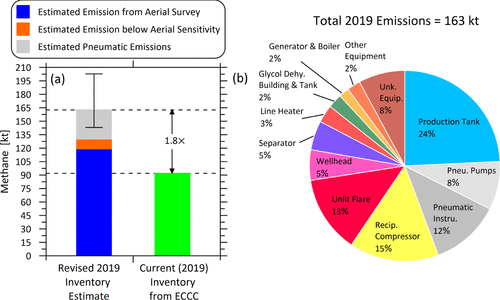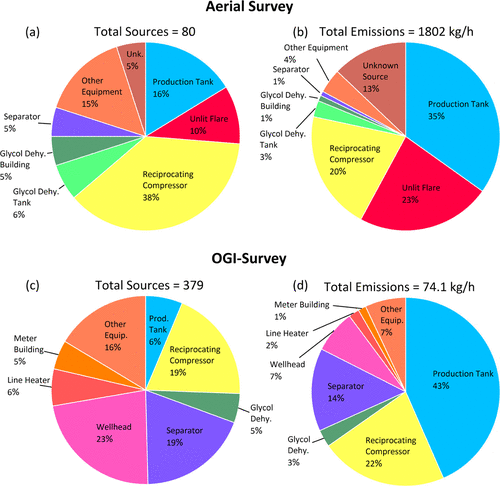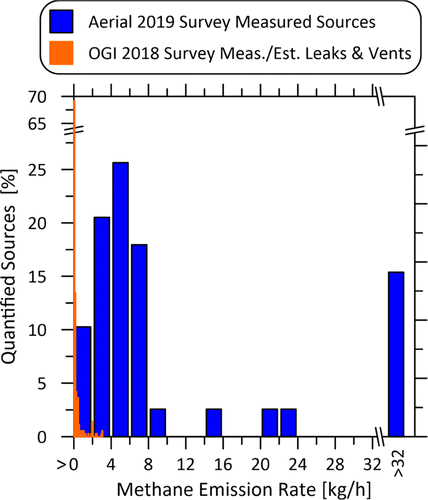Carleton University Study Reveals Important Insights into Measuring Methane Emissions
The “Where the Methane Is,” study was conducted with the goal of deriving a new measurement-based methane inventory for oil and gas facilities in British Columbia, Canada. Carleton University’s Matthew Johnson and David R. Tyner of The Energy Emissions Research Lab conducted the study utilizing onsite OGI survey data combined with aerial scan data from Gas Mapping LiDAR™. Findings from their work provide beneficial new data for the oil and gas industry.
The following are a few of the highlights:
1. Four Sources Accounted for Nearly Three-Quarters of Methane Emissions
To better understand the primary sources of methane leaks, the study combined data from onsite optical gas imaging (OGI) surveys and pneumatic device counts with airborne measurements by Gas Mapping LiDAR. The results revealed that four sources were responsible for 72% of the emissions: production tanks (24%), pneumatic devices (20%), reciprocating compressors (15%), and unlit flares (13%).

Why It’s Important: By having a clearer understanding of the frequency, distribution, and magnitude of various source types driving upstream oil and gas emissions, policy and regulations can focus on these sources to set meaningful reduction targets. Measurements versus estimates also help operators accurately prioritize equipment replacement and repair schedules based on the most common and significant sources of emissions.
2. Data Indicates Emissions in Canada are 1.6 to 2.2 Times Higher Than Estimates
Aerial scans with Gas Mapping LiDAR found significantly larger and many times greater total emissions than the OGI survey. When analyzed in conjunction with equipment count data, the study suggests methane emissions are 1.6 to 2.2 times greater than current inventory estimates.

Why It’s Important: Canada’s current policies and regulations rely on inventory estimates based on OGI survey data, which the study states could run the risk of missing a significant portion of total emissions from tanks and unlit flares. Emerging policies and regulations should be based on meaningful emissions reduction goals using accurate data as a foundation. To amplify this point, CBC News dove deeper into how this could affect the Canadian government's multi-million dollar plan to reduce methane emissions.
3. Aerial LiDAR Detected More Methane Emissions from Fewer Emitters
When compared with the ground-based OGI surveys, Bridger’s aerial LiDAR detected significantly more aggregate emissions on the same set of facilities – as much as 18 times more methane detected – but from far fewer emissions sources. Aerial LiDAR scan data provided high-resolution, geo-located aerial imagery, facility schematics, and equipment counts that enabled equipment-level emission attribution.

Why It’s Important: The results showed that OGI surveys underestimated fugitive emission and abnormal venting that could impact the accuracy of inventories and could miss a significant portion of emissions. Aerial LiDAR found more emissions from fewer sources than the OGI cameras and consistently attributed emissions to source types. By using the results of an aerial Gas Mapping LiDAR scan, operators can improve emissions inventory accuracy and make meaningful impact on emissions reduction with fewer repairs, ensuring that ground crews fix the most important leaks first.
4. Aerial LiDAR Found Leaks OGI Didn’t That Attribute to Undercounted Emissions
The discrepancy in undercounted emissions is attributed to larger (i.e., > 0.6 kg/hr) emissions that were detected by Gas Mapping LiDAR, but that were statistically less likely to be found by ground crews with OGI cameras. The leaks detected by aerial LiDAR tended to be larger than what OGI cameras found. The study notes that this could explain the discrepancies in current inventory estimates versus the results of the study.

Why It’s Important: The benefits of aerial methane detection are increased efficiency for site scans, as well as the aerial versus OGI’s ground-level viewpoint to equipment sources and emissions. Gas Mapping LiDAR’s capabilities help identify emissions in places that are not captured by OGI cameras, suggesting that relying solely on OGI cameras is not optimal to establish accurate inventories, base policy and regulations upon, nor achieve quantifiable emissions reduction goals.
The work being done by the Energy and Emissions Research Laboratory is crucial to better understanding methane emissions at aggregate and source levels. This important study helps identify ongoing improvements that can be made and the technology that can help the oil and gas industry make meaningful improvements.
Read the entire “Where the Methane Is” study here.
Ready to Reduce Your Methane Emissions?
Gas Mapping LiDAR can provide insight into your emissions sources, establish accurate emissions inventories, and help you achieve meaningful methane emissions reduction. Fill out our contact form, and one of our Project Development Coordinators will be in contact.
*All photos and graphs are credited to Matthew Johnson and the team at EERL

%20(1).png?width=575&name=Where%20the%20Methane%20Is%20Feature%20(2)%20(1).png)